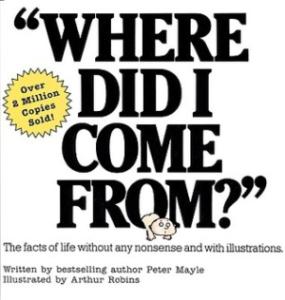California. You came from California.

It's okay. I wouldn't say there's any misinformation in this book. This is actually the book I remember being given by my parents when I was in 3rd grade or so. It's not bad. I don't care for the unrealistic illustrations, although that might be part of the attraction for some people. The book is about babies and just talking about sex to children. It starts out with some superfluous stuff about why the book was written (taking up a few of the precious 43 pages) and then it says, okay, here's some really weird-looking drawings of a man and a woman naked (although good on them for having realistically chubby parents). It lists the major external, then internal, parts that are different between men and women. And then here are the man and the woman in bed "making love" (they don't use the word "sex"). Here's why they do it. Here's why they stop doing it. Then semen comes out of the penis. Here's what sperm would look like if they were cartoon characters. Sperm find eggs. Then the mother is pregnant. Here is a general month by month breakdown of what happens while the baby is in the mother's womb. Then the baby is born. Here's why you have a belly button.
So there's a lot more about babies than sexuality in this book (which is reasonable, given the title). Some nitpicks that I have: okay, obviously you do need two people to make a baby, but calling the two people who made you "your mother" and "your father" really excludes a lot of families. For my children (and for me as a child) that's totally fine. I'm still married to their father. But it excludes children of same-sex couples, children where one or both parents have passed away, children where one parent is not in the picture and a step-parent adopted them-- that's a great deal of children. You could say that they're the "biological" father and mother, but the book doesn't use that term. It just says the two people who made you were your mother and your father. Also, it says, "The milk that kept you alive for those first few months either came from a bottle, or your mother's breasts." So it talks about breastfeeding and bottles but not formula per se. It could use the word "sex" instead of the phrase "making love," although that might just be part of its datedness. And one part I remember from when I was a kid is it describing the feeling of making love as "A gentle tingly sort of tickle" and shows a baby being tickled with a feather on the opposite page. I didn't like being tickled, and decided upon reading this that making love did not sound very enjoyable. But it's not like tickling at all. And it doesn't use the word "orgasm". "Penis," yes, "vagina," yes, "orgasm," no. It also mentions pubic hair without using the word "pubic". It describes the orgasm as being "kind of like a sneeze." Really? As someone with allergies, I can tell you that sneezing is not fun. Again, not doing justice to the enjoyability of sex to someone who's never had it (and pre-adolescence, the general feeling is "ick, why would anyone want to do that?!"). "If two sperm meet two eggs, the result is twins." No mention of identical twins. No mention of cesarean birth, either, which excludes a whole lot of kids. Failing to mention something so common (perhaps more common nowadays?) makes it seem unusual, or even bad. It actually does use the phrase "umbilical cord" in a small side note.
Like I said, it's not a bad book. I don't think there's any misinformation in here, but it definitely could be improved upon. I'm searching for a book to give to my children when they get old enough (the time is fast approaching) and think I'm going to keep looking.